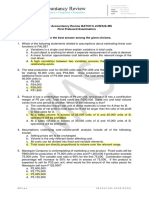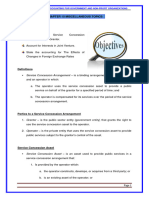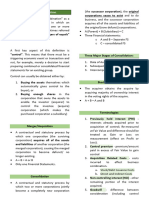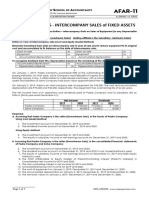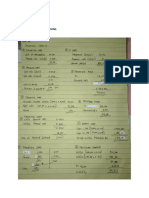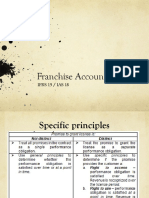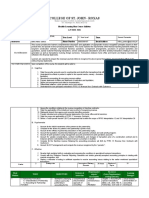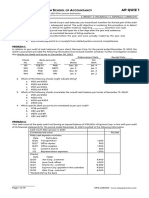V12 AFAR-08 (Business Combinations)
V12 AFAR-08 (Business Combinations)
Uploaded by
Richard VictoriaCopyright:
Available Formats
V12 AFAR-08 (Business Combinations)
V12 AFAR-08 (Business Combinations)
Uploaded by
Richard VictoriaCopyright
Available Formats
Share this document
Did you find this document useful?
Is this content inappropriate?
Copyright:
Available Formats
V12 AFAR-08 (Business Combinations)
V12 AFAR-08 (Business Combinations)
Uploaded by
Richard VictoriaCopyright:
Available Formats
ReSA - THE REVIEW SCHOOL OF ACCOUNTANCY
CPA Review Batch 43 May 2022 CPA Licensure Examination Week No. 8
ADVANCED FINANCIAL ACCOUNTING & REPORTING A. DAYAG C. CAIGA M. NGINA
AFAR-08: BUSINESS COMBINATIONS
BUSINESS COMBINATION- Creating a Single Economic Entity
The term business combination refers in general to any set of conditions in which two or more organizations
are joined together through common ownership.
PFRS 3 Revised
Business combination is a transaction or event in which an acquirer obtains control of one or more
businesses. A business is defined as an integrated set of activities and assets that is capable of being
conducted and managed for the purpose of providing a return directly to investors or other owners,
members or participants.
Scope of PFRS 3 Revised
Formation of all type of joint arrangements (joint venture and joint operations)* x
Acquisition of an asset (a group of assets) that is not a business x
Entities under common control x
Combinations involving mutual entities √
By contract alone (dual listing, stapling) √
x = not within the scope
√ = within the scope
*the scope exception only applies to the financial statements of the joint venture or joint
operation itself and not the accounting for the interest in a joint arrangement in the
financial statements of a party to the joint arrangement.
Classification of BUSINESS COMBINATIONS
Business Combinations may be classified into three schemes:
1. Based on the structure of the combination.
2. Based on the method used to accomplish the combination.
3. Based on the accounting method used.
Structure of the Combination (Business Point of View)
Combinations are classified into four types:
1. Horizontal Integration – this type of combination is one that involves companies within the same
industry that have been previously competitors. A horizontal integration would occur if Shell
Company and Petron Company, both integrated oil companies, were to combine.
2. Vertical Integration – this type of combination take place between two companies involved in the
same industry but at different levels. It normally involves a combination of a company and its
suppliers or customers. For example – a tire manufacturer and a tire distributor; Bally Shoe Company
(a manufacturer of shoes and Rustans Department Store)
3. Conglomerate Combination – is one involving companies in unrelated industries having little, if any,
production or market similarities for the purpose of entering into new markets or industries - such as
a tire manufacturer and an insurance company.
3
4. Circular Combination - entails some diversification, but does not have a drastic change in operation
as a conglomerate. For example – San Miguel Corporation accomplished when they diversify their
activities by putting up Magnolia Products.
Method of Combination (Legal Point of View)
Business combinations are also classified by method of combination into three types – statutory mergers,
statutory consolidations, and stock acquisition.
A Statutory Merger results when one company acquires all the net assets (assets and liabilities) of one or
more other companies through an exchange of stock, payment of cash or other property, or the issue of
debt instruments (or a combination of these methods). The acquiring company survives (remains in
existence), whereas the acquired company (or companies) ceases to exist as a separate legal entity,
although it may be continued as a separate division of the acquiring company.
Page 1 of 10 0915-2303213/0908-6567516 www.resacpareview.com
ReSA – THE REVIEW SCHOOL OF ACCOUNTANCY AFAR-08
Week 8: BUSINESS COMBINATIONS
Thus, if A Company acquires B Company in a statutory merger, the combination is often expressed as:
A Company + B Company = A Company
Or, if B Company acquires A Company:
A Company + B Company = B Company
The Board of Directors of the companies involved, normally negotiate the terms of a plan of merger, which
must be approved by the stockholders of each company involved.
A Statutory Consolidation results when a new corporation is formed to acquire the net assets (assets and
liabilities) two or more other corporations. The acquired company, then cease to exist as separate legal
entities. For example, if C Company is formed to consolidate A Company and B Company, then the
combination is generally expressed as follows:
A Company + B Company = C Company
Stockholders of the acquired companies (A and B) become stockholders in the new entity (C). The
acquired companies may be operated as separate divisions of the new corporation, just as they may
under a statutory merger. Statutory consolidation requires the same type of stockholders approval as in
statutory mergers.
The use of the term consolidation should not be confused with the accounting usage of the same word.
In accounting, consolidation refers to the mechanical process of bringing together the financial records of
two or more organizations to form a single set of statements. Statutory consolidation is a legal term used to
denote a specific type of business combination in which two or more existing companies are united under
the ownership of a newly created company.
A Stock Acquisition occurs when one corporation pays cash or issues stock or debt for all part of the voting
stock of another company, and the acquired companies remained intact as a separate legal entity. If the
acquiring company acquires more than 50% of the voting stock of the acquired company, for example, if
A Company acquires 75% of the voting stock of B Company, a parent-subsidiary relationship results.
Consolidated financial statements (explained in later topics) are prepared and the business combination
is often expressed as:
Financial Statements of A Co. + Financial Statements of B. Co.
=
Consolidated Financial Statements of A Co. and B Co.
The stock may be acquired through market purchases or through direct purchase from, or exchange with,
individual stockholders of the subsidiary company. Sometimes stock is acquired through a tender offer,
which is an open offer to purchase up to a stated number of shares of a given corporation at a stipulated
price per share. The offering price is generally set somewhat above the current market price of the shares
in order to provide an additional incentive to prospective sellers. The investee or subsidiary company
continues its legal existence and the investor or parent company records its acquisition in its records as a
long-term investment.
Although business combination is a broad term encompassing all forms of combination and the terms
merger and consolidation and stock acquisition have technical, legal definitions, the three terms are often
used interchangeably in practice. Thus, one cannot always rely on the accuracy of the term used to
identify the type of combination, but, must look to the facts of the situation to determine its accounting
treatment.
Method of Accounting for Business Combinations
The acquisition method is used for all business combinations. The pooling of interests method is prohibited.
Acquirer must be identified. Under PFRS No. 3, an acquirer must be identified for all business combinations.
Identification of an Acquirer
Control. The acquirer is the combining entity that obtains control of the other combining entities or
businesses. PFRS No. 3 provides considerable guidance for identifying the acquirer.
Other indicators of which party was the acquirer in any given business combinations are as follows (these
are suggestive only, not conclusive):
1. The fair value of one entity is significantly greater than that of the other combining enterprises; in
such a case, the larger entity would be deemed the acquirer.
2. The combination is effected by an exchange of voting stock for cash; the entity paying the cash
would be deemed to be the acquirer.
3. Management of one enterprise is able to dominate selection of management of the combined
entity; the dominant entity would be deemed to be the acquirer.
Page 2 of 10 0915-2303213/0908-6567516 www.resacpareview.com
ReSA – THE REVIEW SCHOOL OF ACCOUNTANCY AFAR-08
Week 8: BUSINESS COMBINATIONS
Recognizing and Measuring Goodwill and Gain from a Bargain Purchase
As a result of the PFRS 3 Revised, the way in which goodwill or a gain on a bargain purchase is calculated
has changed, being the difference between:
I. The sum of:
the fair value of the consideration transferred
the recognized amount of any non-controlling interest in the acquire
for a business combination achieved in stages, the fair value of any previously held equity
interest in the acquiree; and
II. The acquisition-date recognized fair value amount of the identifiable assets acquired and liabilities
assumed.
Goodwill arises when I exceed II, under:
➢ Option 1: “Full” Goodwill Method – there is a non-controlling interest share in the goodwill.
➢ Option 2: “Partial/Proportionate Basis” Goodwill Method – there is no non-controlling interest
share in the goodwill.
Bargain purchase arises when II exceeds I. When a bargain purchase (as previously defined) occurs,
a gain on acquisition is recognized in the profit or loss. While this is consistent with the
pronouncement of PFRS 3 (old) under Option 2, the amount recognized may differ, due to the other
changes in the PFRS 3 Revised (new) which may also allow Option 1. It is under Option (1) where
there is an inconsistency of recognition of gain, wherein any excess that remains is recognized as a
gain, which is attributable only to the acquirer (or parent company).
Before concluding that bargain purchase (or discount on acquisition) has arisen, however, PFRS No.
3 requires that the acquirer shall:
1. reassess the identification and measurement of the acquiree's identifiable assets, liabilities,
and contingent liabilities and the measurement of the cost of the combination; and
2. recognize immediately in profit or loss any excess remaining after that reassessment.
Consideration transferred
For the purposes of applying the acquisition method, the fair value of the consideration transferred in
exchange for the acquirer’s interest in the acquiree is calculated as the sum of:
a. the acquisition-date fair values of the assets transferred by the acquirer, liabilities assumed or
incurred by the acquirer, and equity interests issued by the acquirer. Examples include cash, other
assets, contingent consideration, a business or a subsidiary of the acquirer, common or preferred
equity instruments, options, warrants, and member interests of mutual entities; and
b. the acquisition-date fair value of any non-controlling equity investment in the acquiree that the
acquirer owned immediately before the acquisition date.
The consideration transferred may include assets or liabilities of the acquirer that have carrying amounts
that differ from their fair values at the acquisition date (for example, non-monetary assets or a business of
the acquirer). In that case, the acquirer shall remeasure those transferred assets or liabilities to their fair
values as of the acquisition date and recognize any gains or losses in profit or loss. However, if those assets
or liabilities are transferred to the acquiree and, therefore, remain within the combined entity after the
business combination, the acquirer shall eliminate any gains or losses on those transferred assets or liabilities
in the consolidated financial statements.
The acquisition-date fair value of the consideration transferred, including the fair value of each major class
of consideration, such as:
1. Cash or other monetary assets. The fair value is the amount of cash or cash equivalent dispersed.
The amount is usually readily available.
2. For deferred payment, the fair value to the acquirer is the amount the entity would have to borrow
to settle their debt immediately. Hence, the discount rate used is the entity’s incremental borrowing
rate.
3. Non-monetary assets. These consist of assets such as property, plant and equipment, investments,
licenses and patents. If active second-hand market price exists, fair values can be obtained by
reference to those markets. Where active markets do not exist, other means of valuation, including
the use of expert valuers, may be used.
4. Equity Instruments. If an acquirer issues its own shares as consideration, it will need to determine the
fair value of those shares at the date of exchange.
Page 3 of 10 0915-2303213/0908-6567516 www.resacpareview.com
ReSA – THE REVIEW SCHOOL OF ACCOUNTANCY AFAR-08
Week 8: BUSINESS COMBINATIONS
5. Debt instruments/Liabilities undertaken. The fair values of liabilities undertaken are best measured
by the present value of future cash outflows. As noted in PFRS 3, future losses or other costs expected
to be incurred as a result of the business combination are not liabilities of the acquirer and are
therefore not included in the calculation of the fair value of consideration paid. These must be
treated as post-combination expenses.
6. Contingent consideration. The acquirer shall recognize the acquisition-date fair value of contingent
consideration. PFRS 3 Revised has formally defined contingent consideration as additional
consideration by the acquirer to the former owners (or return of consideration from the former
owners).
Changes that are the result of the acquirer obtaining additional information about facts and
circumstances that existed at the acquisition date, and that occur within the measurement period
(which may be a maximum of one year from the acquisition date), are recognized as adjustments
against the original accounting for the acquisition (and so may impact goodwill). Changes resulting
from events after the acquisition date are not measurement period adjustments. Such changes are
therefore accounted for separately from the business combination.
Costs and Expenses of Business Combination
The PFRS 3 Revised states that acquisition-related costs are costs incurred by the acquirer to effect a
business combination, including reimbursements to the acquiree for bearing some of the acquisition costs,
except costs of issuing debt instruments are accounted for under PFRS 9, and costs of issuing equity
instruments are accounted for under PAS 32, shall be accounted for as expenses in the periods in which
they are incurred. They are summarize as follows:
Acquisition-related costs Examples Treatment
1. Directly attributable costs professional fees paid to Expenses
accountants, legal advisers, valuers,
and other consultants (finders and
brokerage fees) to effect the
combination.
2. Indirect acquisition costs general and administrative costs, Expenses
including the costs of maintaining an
internal acquisitions department
(management salaries, depreciation,
rent, and costs incurred to duplicate
facilities) and other costs of which
cannot be directly attributed to the
particular acquisition
3. Costs of issuing securities transaction costs such as stamp Debit to APIC/Share
(issue and register stocks)* duties, professional adviser’s fees, Premium Account
underwriting costs and brokerage
fees may be incurred
*Similarly, the cost of arranging (registering) and issuing debt securities or financial liabilities are an
integral part of the liability issue transaction (Bond Issue Costs).
Allocating the cost of the business combination
Par. 36 of PFRS 3 includes the following statements:
“The acquirer shall measure and recognize as of the acquisition date the assets acquired and
liabilities assumed as part of the business combination. The identifiable assets acquired and
liabilities assumed shall be measured at fair value and recognized separately from goodwill.”
Recognition of Acquired Assets and Liabilities
The allocation of acquired assets and liabilities measurement which is at fair value occurs at acquisition
date. The allocation requires the recognition of:
1. Identifiable Tangible Assets. An asset other than an intangible asset is recognized if it is probable
(probability test) that any associated future economic benefits will flow to the acquirer, and its
fair value can be measured reliably (reliability test).
2. Identifiable Intangible Assets. PFRS 3 Revised requires the acquirer to recognize identifiable
assets acquired regardless of the degree of probability of an inflow of economic benefits. This
change emphasizes the expectation that all intangible assets that satisfy the definition criteria
in PAS 38, if acquired as part of a business combination, must be recognized.
Page 4 of 10 0915-2303213/0908-6567516 www.resacpareview.com
ReSA – THE REVIEW SCHOOL OF ACCOUNTANCY AFAR-08
Week 8: BUSINESS COMBINATIONS
An intangible asset is identifiable if it:
➢ can be separated; or
➢ meets the contractual-legal criterion e.g. license to operate a nuclear power plant is an
intangible asset, even though the acquirer cannot sell or transfer the license separately
from the acquired power plant.
The acquirer shall recognize, separately from goodwill, the acquisition-date fair value of intangible
assets acquired in a business combination that meet the definition of an intangible asset in PAS 38.
Examples that would meet the definition of Intangible Assets:
a. Marketing-related intangible assets:
- trademarks, trade names, service marks, collective marks and certification marks
- internet domain names
- trade dress – unique color, share or package design
- newspaper mastheads
- non-competition assets
b. Customer-related intangible assets:
- customer lists
- order or production backlog
- customer contracts and the related customer relationships
- non-contractual customer relationships
c. Artistic-related intangible assets:
- plays, operas and ballets
- books, magazines, newspapers and other literary works
- musical works such as compositions, song lyrics, and advertising jingles
- pictures and photographs
- video and audiovisual material, including films, music videos, and television programs
d. Contract-based intangible assets
- licensing, royalty, and standstill agreements
- advertising, construction, management, service or supply contracts
- lease agreements
- construction permits
- franchise agreements
- operating and broadcasting rights
- use rights such as drilling, water, timber-getting and route authorities
- servicing contracts such as mortgage servicing contracts
- employment contracts priced below their market value
e. Technology-based intangible contracts
- patented technology
- computer software and mask works
- unpatented technology
- databases
- trade secrets such as secret formulas, processes or recipes
3. Liabilities. A liability other than a contingent liability is recognized if it is probable that an outflow
of resources will be required to settle the obligation, and its fair value can be measured reliably.
4. Contingent Liabilities. PFRS No. 3 Revised requires recognition of a contingent liability (of the
acquiree) assumed in a business combination will be recognize at their fair values if it is a present
obligation that arises from past events and its fair value can be measured reliably, regardless of
the probability of a cash flow arising.
******
Every great success was at the beginning impossible.
Opportunities are usually disguised as hard work, so most people don’t recognize them.
A goal is nothing more than a dream with a time limit.
I
Tree Corporation is a company involved in manufacturing cars. On January 1, 2019, the board of directors of the
said company has decided to acquire the net assets of Knee Corporation and Dudd Corporation, suppliers of
materials they use in production. The merger is expected to result in producing higher quality cars with lower total
cost. The following information was gathered from the books of the entities on January 1, 2019:
Page 5 of 10 0915-2303213/0908-6567516 www.resacpareview.com
ReSA – THE REVIEW SCHOOL OF ACCOUNTANCY AFAR-08
Week 8: BUSINESS COMBINATIONS
Tree Knee Dudd
Current Assets................................................................. P 1,375,000 P 390,000 P 260,000
Noncurrent Assets.......................................................... 3,125,000 2,550,000 1,700,000
Liabilities.......................................................................... 325,000 210,000 140,000
Ordinary Share Capital, P100 par................................ 2,748,500 1,780,200 1,186,800
Share Premium – Ordinary Share.................................. 176,500 169,800 113,200
Accumulated Profits (Losses)......................................... 1,250,000 780,000 520,000
Tree will issue 22,500 of its ordinary shares in exchange for the net assets of Knee and 11,200 of its ordinary shares
in exchange for the net assets of Dudd. The fair value of Tree’s shares is P150. In addition, the following fair values
were available:
Knee Dudd
Current Assets........................................................ P 450,000 P 230,000
Noncurrent Assets................................................. 2,150,000 1,975,000
The following out of pocket costs of the combination were as follows:
Legal fees for the contract of business combination........................ P 8,000
Audit fee for SEC registration of share issue........................................ 9,000
Printing costs of share certificates........................................................ 5,000
Broker’s fee ............................................................................................ 4,000
Accountant’s fee for pre-acquisition audit........................................ 10,000
Other direct cost of acquisition............................................................ 7,000
Internal secretarial, general and allocated expenses...................... 9,000
Documentary stamp tax on the new shares...................................... 2,000
Required:
1. Record the acquisition of the net assets of Knee and Dudd and related transactions on the books of
Tree.
2. Determine the following amounts that will appear in the balance sheet of Tree on January 1, 2019:
a. Goodwill arising from acquisition of Knee
b. Gain on acquisition of Dudd (to be added to accumulated P&L)
c. Current assets
d. Noncurrent assets
e. Total assets
f. Total liabilities
g. Ordinary share capital
h. Share premium
i. Accumulated profits (losses)/retained earnings
j. Shareholders’equity
3. (Cash Contingency) Determine the amount of goodwill arising from business combination of assuming
that Tree agreed to pay an additional P500,000 on January 1, 2021 to Knee Company, if the average
income of Knee Company during the 2-year period of 2019 - 2020 exceeds P5,000,000 per year. The
expected value is P200,000 calculated based on the 40% probability of achieving the target average
income. The amount of goodwill arising from acquisition amounted to:
4. Assuming the same facts as in (3) above. Before the contingency period is over, the probability present
value of the earnings contingency declines to P180,000, determine the amount of goodwill if the
changes in:
a. the value is within the measurement period (due to facts and circumstances existing as of the
date of acquisition).
b. the value is due to events occurring subsequent to acquisition.
5. (Stock Contingency with Market Value Given). In addition to the stock issue, Tree Company also agreed
to issue additional shares of common stock to the former stockholders of Knee Company if the average
post-combination earnings over the next two years equaled or exceeded P5,000,000 per year. The
additional 2,000 shares expected to be issued are valued at P320,000.
On January 1, 2021, the earnings for 2019 and 2020 amounted to P5,000,000 and P5,350,000,
respectively.
Required:
a. Determine the amount of goodwill on January 1, 2019
b. The entry on January 1, 2021.
Page 6 of 10 0915-2303213/0908-6567516 www.resacpareview.com
ReSA – THE REVIEW SCHOOL OF ACCOUNTANCY AFAR-08
Week 8: BUSINESS COMBINATIONS
6. (Stock Contingency). In addition to the stock issue, Tree Company also agreed to issue additional 2,000
shares of common stock to the former stockholders of Knee Company two years later if the fair value of
acquirer (Tree’s common stock) fell below P150 per share.
On January 1, 2021, the contingent event happens and the common stock of Tree had a fair value
below P150.
Required:
a. Determine the amount of goodwill on January 1, 2019
b. The entry on January 1, 2021.
c. The entry on January 1, 2021, if the fair value of stock increase to P155:
7. (Stock Contingency). In addition to the stock issue, Tree Company also agreed to issue additional shares
of common stock to the former stockholders of Knee Company on January 1, 2021, to compensate for
any fall in the market value of Tree common stock below P150 per share. The settlement would be to
cure the deficiency by issuing added shares based on their fair value on January 1, 2021.
On January 1, 2021, the contingent event happens and the stock had a fair value of P135.
Required:
a. Determine the amount of goodwill on January 1, 2019
b. The entry on January 1, 2021.
II – with Answer
Pam Company is acquiring the net assets of Jam Company for an agreed-upon price of P900,000 on July
1, 20x4. The value was tentatively assigned as follows:
Current assets…………………………………………………………..................... P 100,000
Land…………………………………………………………………………………… 50,000
Equipment………………………………………………………………………......... 200,000 (5-year life)
Building…………………………………………………………………………........... 500,000 (20-year life)
Current liabilities…………………………………………….................................... ( 150,000)
Goodwill…………………………………………………………………………........ 200,000
Values were subject to change during the measurement period. Depreciation is taken to the nearest
month. The measurement period expired on July 1, 20x5, at which time the fair values of the equipment
and building as of the acquisition data was revised to P180,000 and P550,000, respectively.
At the end of 20x5, what adjustments are needed for the financial statements for the period ending
December 31, 20x4 and 20x5?
Answers:
The 20x4 financial statements would be revised as they are included in the 20x4 – 20x5 comparative
statements. The 20x4 statements would be based on the new values. The adjustments would be:
(a) The equipment and building will be restated at P180,000 and P550,000 on the comparative 20x4 and
20x5 balance sheets.
(b) Originally, depreciation on the equipment was P40,000 (P200,000/5) per year. It will be recalculated
as P36,000 (P180,000/5) per year. The adjustment for 20x4 is for a half year 20x4 depreciation expense
and accumulated depreciation will be restated at P18,000 instead of P20,000 for the half year.
Depreciation expense for 20x5 will be P36,000.
(c) Originally, depreciation on the building was P25,000 (P500,000/20) per year. It will be recalculated as
P27,500 (P550,000/20) per year. The adjustment for 20x4 is for a half year 20x4 depreciation expense
and accumulated depreciation will be restated at P13,750 instead of P12,500 for the half year.
Depreciation expense for 20x5 will be P27,500.
(d) Goodwill is reduced P30,000 on the comparative 20x4 and 20x5 balance sheets.
III
TT Corporation acquired assets and assumed liabilities of SS Corporation’s on December 31, 20x4. Balance
sheet data for the two companies immediately following the acquisition follow:
Item TT Corporation SS Corporation
Cash . . . . . . . . . . . . . . . . . . . . . . . . . . . . . . . . . . . . . . P 49,000 P 30,000
Accounts Receivable . . . . . . . . . . . . . . . . . . . . . . . . 110,000 45,000
Inventory . . . . . . . . . . . . . . . . . . . . . . . . . . . . . . . . . . 130,000 70,000
Land . . . . . . . . . . . . . . . . . . . . . . . . . . . . . . . . . . . . . . 80,000 25,000
Buildings and Equipment . . . . . . . . . . . . . . . . . . . . . . 500,000 400,000
Page 7 of 10 0915-2303213/0908-6567516 www.resacpareview.com
ReSA – THE REVIEW SCHOOL OF ACCOUNTANCY AFAR-08
Week 8: BUSINESS COMBINATIONS
Less: Accumulated Depreciation . . . . . . . . . . . . . . (223,000) (165,000)
Investment in SS Corporation Stock . . . . . . . . . . . . __198,000 _________
Total Assets . . . . . . . . . . . . . . . . . . . . . . . . . . . . . . . . P 844,000 P 405,000
Accounts Payable . . . . . . . . . . . . . . . . . . . . . . . . . . . . 61,500 28,000
Taxes Payable . . . . . . . . . . . . . . . . . . . . . . . . . . . . . . . . 95,000 37,000
Bonds Payable . . . . . . . . . . . . . . . . . . . . . . . . . . . . 280,000 200,000
Common Stock . . . . . . . . . . . . . . . . . . . . . . . . . . . . 150,000 50,000
Retained Earnings . . . . . . . . . . . . . . . . . . . . . . . . . . . . _257,500 ___90,000
Total Liabilities and Stockholders' Equity . . . . . . . . . . P 844,000 P 405,000
At the date of the business combination, the book values of SS’s net assets and liabilities approximated fair
value except for inventory, which had a fair value of P85,000, and land, which had a fair value of
P45,000.Indicate the appropriate total that should appear in the balance sheet prepared immediately
after the business combination.
1. What amount of inventory will be reported?
a. P70,000. c. P200,000
b. P130,000. d. P215,000
2. What amount of goodwill will be reported?
a. P-0- c. P43,000
b. P23,000 d. P58,000
3. What amount of total assets will be reported?
a. P84,400 c. P1,109,000
b. P1,051,000 d. P1,249,000
4. What amount of total liabilities will be reported?
a. P265,000 c. P701,500
b. P436,500 d. P1,249,000
5. What amount of retained earnings will be reported?
a. P547,500 c. P347,500
b. P397,500 d. P257,500
6. What amount of total stockholders’ equity will be reported?
a. P407,500 c. P844,000
b. P547,500 d. P1,249,000
IV
Geri acquired the net assets of Mark Corp. on July 1, 20x5. In exchange for net assets at fair market value
of Mark Co. amounting to P835,740, Geri issued 81,600 shares at a market price of P12 per share (P9 par
value). Out of pocket costs of the combination were as follows:
Legal fees for the contract of business combination................................. P 10,000
Audit fee for SEC registration of share issue ................................................ 13,000
Costs of shares of stock certificates ............................................................. 7,000
Broker’s fee ..................................................................................................... 8,000
Other direct cost of acquisition ................................................................... 22,000
General and allocated expenses ............................................................... 25,000
Geri will pay an additional cash consideration of P546,000 in the event that Mark’s net income will be equal
or greater than P1,140,000 for the period ended December 31, 20x5. At acquisition, there is a high
probability of reaching the target net income and the fair value of the additional consideration was
determined to be P234,000. Actual net income for the period ended December 31, 20x5 amounted to
P1,500,000. The additional consideration was paid.
1. What is the amount of goodwill to be recognized in the statement of financial position as of December
31, 20x5?
a. P -0- c. P377,460
b. P257,040 d. P425,640
2. What amount chargeable to operations (loss/expense) to be recognized for the year ended December
31, 20x5?
a. P -0- c. P377,000
b. P337,000 d. P397,000
V
The balance sheet of Salt Company, along with market values of its assets and liabilities, is as follows:
Salt Company
Book value: dr (cr) Market value: dr (cr)
Current assets P 2,000,000 P 1,500,000
Plant & equipment (net) 30,000,000 35,000,000
Patents 100,000 2,000,000
Completed technology 0 10,000,000
Page 8 of 10 0915-2303213/0908-6567516 www.resacpareview.com
ReSA – THE REVIEW SCHOOL OF ACCOUNTANCY AFAR-08
Week 8: BUSINESS COMBINATIONS
Broader customer base 0 16,000,000
Technically skilled workforce 3,000,000
Potentially profitable future contracts 2,000,000
Licensing agreements 0 4,000,000
Potential contracts with new customers 1,500,000
Potential advertising jingles 1,000,000
Future cost savings 1,800,000
Goodwill 200,000 700,000
Liabilities (28,000,000) (30,000,000)
Common stock, P10 par (1,000,000)
Additional paid-in capital (5,000,000)
Retained earnings 1,700,000
1. Pail Company pays P100,000,000 in cash for Salt Company’s assets and liabilities. Pail records goodwill
of:
a. P50,800,000 c. P72,500,000
b. P66,800,000 d. P77,500,000
2. Now assume Pail Company pays P10,000,000 in cash to acquire the assets and liabilities of Salt
Company. Pail records a bargain purchase gain on acquisition of:
a. Zero c. P17,500,000
b. P12,500,000 d. P28,500,000
3. Pail paid P100,000,000 in cash for Salt. Three months later, Salt’s patents are determined to have been
worthless as of the date of acquisition. The entry to record this information includes
a. a debit to loss of P2,000,000.
b. a debit to patents of P2,000,000.
c. A debit to goodwill of P2,000,000.
d. A debit to retained earnings of P2,000,000.
4. Pail paid P10,000,000 in cash for Salt. Three months later, it is determined that Seattle’s acquisition-date
liabilities omitted a pending lawsuit valued at P2,000,000. The entry to record this information includes
a. a debit to bargain purchase gain on acquisition of P2,000,000.
b. a debit to liabilities of P2,000,000.
c. A debit to goodwill of P2,000,000.
d. A debit to retained earnings of P2,000,000.
VI
Kelly Corporation acquires Lawson Co. in a statutory merger. Below is the balance sheet of Lawson at
the date of acquisition.
Book value Market value
Dr(cr) Dr(cr)
Current assets P 1,000,000 P 4,000,000
Plant & equipment 50,000,000 70,000,000
Identifiable intangibles 20,000,000 30,000,000
Goodwill 4,000,000 7,000,000
Current liabilities (2,000,000) (2,000,000)
Long-term liabilities (52,000,000) (52,000,000)
Capital stock (3,000,000)
Retained earnings (18,000,000)
1. Kelly issues stock with a market value of P58,000,000 for Lawson. How much goodwill does Kelly record?
a. P 1,000,000 c. P 8,000,000
b. P 7,000,000 d. P10,000,000
2. Assume that three months after the acquisition, additional identifiable intangibles, belonging to Lawson
at the date of acquisition, are discovered. These intangibles have a market value of P500,000. The
entry to reflect this new information includes
a. a credit to goodwill of P500,000. c. a gain of P500,000.
b. a credit to intangible assets of P500,000. d. a loss of P500,000.
3. Assume that a year after the acquisition, it is determined that because of a downturn in the economy
and resulting reduction in sales, the acquired plant and equipment is only worth P60,000,000. The entry
to reflect this new information includes
a. a debit to goodwill of P10,000,000.
b. a debit to plant and equipment of P10,000,000.
c. a gain of P10,000,000.
d. a loss of P10,000,000.
Page 9 of 10 0915-2303213/0908-6567516 www.resacpareview.com
ReSA – THE REVIEW SCHOOL OF ACCOUNTANCY AFAR-08
Week 8: BUSINESS COMBINATIONS
VII
During its inception, Devon Company purchased land for P100,000 and a building for P180,000. After
exactly 3 years, it transferred these assets and cash of P50,000 to a newly created subsidiary, Regan
Company, in exchange for 15,000 shares of Regan's P10 par value stock. Devon uses straight-line
depreciation. Useful life for the building is 30 years, with zero residual value.
1. At the time of the transfer, Regan Company should record:
a. Building at P180,000 and no accumulated depreciation
b. Building at P162,000 and no accumulated depreciation.
c. Building at P200,000 and accumulated depreciation of P24,000.
d. Building at P180,000 and accumulated depreciation of P18,000.
2. Regan Company will report
a. additional paid-in capital of P0
b. additional paid-in capital of P150,000
c. additional paid-in capital of P162,000
d. additional paid-in capital of P180,000
VIII
Envigo Corporation acquired all the assets and liabilities of CFC Corporation by issuing shares of its common stock On
January 1, 2019. Partial balance sheet data for the companies prior to the business combination and immediately
following the combination is provided:
Envigo CFC
Book Value Book Value Combination
Cash P 65,000 P 25,000 P 90,000
Accounts receivable 72,000 20,000 94,000
Inventory 33,000 45,000 88,000
Buildings and equipment (net) 400,000 150,000 650,000
Goodwill ________ ________ _______?
Total Assets P 570,000 P 240,000 P ?
Accounts payable P 50,000 P 25,000 P 75,000
Bonds payable 250,000 100,000 350,000
Common stock, P2 par 100,000 25,000 160,000
Additional paid-in capital 65,000 20,000 245,000
Retained earnings 105,000 70,000 _______?
Total Liabilities and Equities P 570,000 P 240,000 P ?
1. What number of shares did Envigo issue for this acquisition?
a. P80,000 c. P30,000
b. P50,000 d. P17,500
2. At what price was Envigo stock trading when stock was issued for this acquisition?
a. P2.00 c. P6.00
b. P5.63 d. P8.00
3. What was the fair value of the net assets held by CFC at the date of combination?
a. P115,000 c. P270,000
b. P227,000 d. P497,000
4. What amount of goodwill will be reported by the combined entity immediately following the
combination?
a. P 13,000 c. P173,000
b. P125,000 d. P413,000
5. What balance in retained earnings will the combined entity report immediately following the
combination?
a. P35,000 c. P105,000
b. P70,000 d. P175,000
GOD’s LOVE is like a river that keeps on flowing.
Page 10 of 10 0915-2303213/0908-6567516 www.resacpareview.com
You might also like
- RESA - AFAR Preweek Lecture 2Document15 pagesRESA - AFAR Preweek Lecture 2MellaniNo ratings yet
- AFAR Self Test - 9005Document6 pagesAFAR Self Test - 9005King MercadoNo ratings yet
- Business CombinationDocument7 pagesBusiness CombinationAlarich CatayocNo ratings yet
- Auditing Problems Test Banks - SHE Part 1Document5 pagesAuditing Problems Test Banks - SHE Part 1Alliah Mae ArbastoNo ratings yet
- MS 1st Preboard Questionaires PDFDocument15 pagesMS 1st Preboard Questionaires PDFCharilyn RemigioNo ratings yet
- Afar 2 Testbank Business CombinationDocument30 pagesAfar 2 Testbank Business Combinationjeromedeiparine8No ratings yet
- CDD Acctg. For Bus - Co Preliminary ExaminationDocument25 pagesCDD Acctg. For Bus - Co Preliminary ExaminationMaryjoy Sarzadilla JuanataNo ratings yet
- Chapter 15 Miscellaneous TopicsDocument6 pagesChapter 15 Miscellaneous TopicsAngelica Joy ManaoisNo ratings yet
- Acco 30023 Q1 PDFDocument7 pagesAcco 30023 Q1 PDFMika MolinaNo ratings yet
- Business CombinationDocument15 pagesBusiness CombinationHarah LamanilaoNo ratings yet
- 9.1 Equity Investments at Fair Value PDFDocument4 pages9.1 Equity Investments at Fair Value PDFJorufel PapasinNo ratings yet
- FAR-4105: INVENTORIES - Part 1: - T R S ADocument6 pagesFAR-4105: INVENTORIES - Part 1: - T R S AJohn Paulo SamonteNo ratings yet
- Solutions:: Problem 2Document2 pagesSolutions:: Problem 2AlexNo ratings yet
- Acc 202 Ast ReviewerDocument193 pagesAcc 202 Ast ReviewerMA. CHRISTINA BUSAINGNo ratings yet
- Practice Problems Corporate LiquidationDocument2 pagesPractice Problems Corporate LiquidationAllira OrcajadaNo ratings yet
- ReSA B47 RFBT First PB Exam - Questions & AnswersDocument14 pagesReSA B47 RFBT First PB Exam - Questions & AnswersAccounting StuffNo ratings yet
- AFAR-11 (Consolidated FS - Intercompany Sales of Fixed Assets)Document7 pagesAFAR-11 (Consolidated FS - Intercompany Sales of Fixed Assets)MABI ESPENIDONo ratings yet
- Corporate Liquidation & Joint Venture2Document5 pagesCorporate Liquidation & Joint Venture2jjjjjjjjjjjjjjjNo ratings yet
- Solution AP Test Bank 1Document8 pagesSolution AP Test Bank 1ima100% (1)
- Ncpar Cup 2012Document18 pagesNcpar Cup 2012Allen Carambas Astro100% (2)
- ACCO 30033 LGUs With AnswersDocument3 pagesACCO 30033 LGUs With AnswersMika MolinaNo ratings yet
- CHAPTER 8 - Audit of Liabilities: Problem 1Document27 pagesCHAPTER 8 - Audit of Liabilities: Problem 1Mikaela Gale CatabayNo ratings yet
- Quiz 3 - Problems & SollutionsDocument12 pagesQuiz 3 - Problems & SollutionsRiezel PepitoNo ratings yet
- Business Combi TsetDocument28 pagesBusiness Combi Tsetsamuel debebeNo ratings yet
- ABC FinalsDocument10 pagesABC Finalsnena cabañesNo ratings yet
- Chapter 10 Insurance Contracts, Accounting For Build-Operate-Transfer (BOT) - PROFE01Document17 pagesChapter 10 Insurance Contracts, Accounting For Build-Operate-Transfer (BOT) - PROFE01Steffany RoqueNo ratings yet
- Franchise AccountingDocument25 pagesFranchise AccountingKaren Sing Balibalos100% (2)
- FAR 103 ACCOUNTING FOR RECEIVABLES AND NOTES RECEIVABLE PDF PDFDocument4 pagesFAR 103 ACCOUNTING FOR RECEIVABLES AND NOTES RECEIVABLE PDF PDFvhhhNo ratings yet
- MOD2 Corporate LiquidationDocument4 pagesMOD2 Corporate LiquidationJasper Andrew AdjaraniNo ratings yet
- Quiz 2Document20 pagesQuiz 2randomlungs121223No ratings yet
- AMERIL Chapter 1 (Pp.1-17)Document6 pagesAMERIL Chapter 1 (Pp.1-17)Nairah M. TambieNo ratings yet
- CRC Auditing Oct 2022 (1st PB)Document18 pagesCRC Auditing Oct 2022 (1st PB)Rodmae VersonNo ratings yet
- RFBT AssessmentDocument9 pagesRFBT AssessmentJirah Bernal100% (1)
- Mas - 10, 11, 12 Multiple-Choice Questions (MCQS)Document37 pagesMas - 10, 11, 12 Multiple-Choice Questions (MCQS)joooNo ratings yet
- Chapter 1 and DIYDocument8 pagesChapter 1 and DIYJymldy EnclnNo ratings yet
- Manila Cavite Laguna Cebu Cagayan de Oro Davao: AP Ocampo/Ocampo Preweek Lecture MAY 2023Document5 pagesManila Cavite Laguna Cebu Cagayan de Oro Davao: AP Ocampo/Ocampo Preweek Lecture MAY 2023Miguel ManagoNo ratings yet
- ReSA B47 AFAR Final PB Exam - Questions, Answers & SolutionsDocument24 pagesReSA B47 AFAR Final PB Exam - Questions, Answers & SolutionsAngelica IlaganNo ratings yet
- AFARDocument10 pagesAFARMaeflor LotoNo ratings yet
- Current LiabilitiesDocument9 pagesCurrent LiabilitiesErine ContranoNo ratings yet
- Insurance Contracts and Service ConcessionDocument2 pagesInsurance Contracts and Service Concessionss calogsNo ratings yet
- Afar 09Document14 pagesAfar 09RENZEL MAGBITANGNo ratings yet
- Chapter 23-14Document3 pagesChapter 23-14Janna rae BionganNo ratings yet
- RFBT - CPAR Final PreboardDocument14 pagesRFBT - CPAR Final PreboardKIM RODANo ratings yet
- Mock Board Ref 2Document10 pagesMock Board Ref 2nglc srzNo ratings yet
- Accounting 7an Business CombinationDocument8 pagesAccounting 7an Business CombinationLabLab ChattoNo ratings yet
- 8921 - Intercompany Transactions Fixed AssetsDocument2 pages8921 - Intercompany Transactions Fixed AssetsThalia BontigaoNo ratings yet
- This Study Resource WasDocument2 pagesThis Study Resource WasTrixie HicaldeNo ratings yet
- Midterm SheDocument5 pagesMidterm SheKaye Delos SantosNo ratings yet
- CPA Review School of The Philippin: First Pre-Board Examination Regulatory Framework For Business TransactionsDocument11 pagesCPA Review School of The Philippin: First Pre-Board Examination Regulatory Framework For Business TransactionsSophia PerezNo ratings yet
- Home OfficeDocument17 pagesHome OfficeNiki DimaanoNo ratings yet
- Law 9Document2 pagesLaw 9Crissa Mae Falsis100% (1)
- May 2017 Advanced Financial Accounting & Reporting Final Pre-BoardDocument20 pagesMay 2017 Advanced Financial Accounting & Reporting Final Pre-BoardPatrick ArazoNo ratings yet
- ACCT201 Accounting For Special TransactionsDocument7 pagesACCT201 Accounting For Special TransactionsMiles SantosNo ratings yet
- Lyceum First Preboard 2020Document3 pagesLyceum First Preboard 2020Jordan Tobiagon100% (1)
- RFBT - Insurance LawDocument2 pagesRFBT - Insurance LawHelpieNo ratings yet
- AP Quiz 1 (B46)Document19 pagesAP Quiz 1 (B46)Jacqueline OrtegaNo ratings yet
- AFAR-07:Home Office and Branch AccountingDocument8 pagesAFAR-07:Home Office and Branch AccountingJhekka FerrerNo ratings yet
- V14 and V15 AFAR-12 (Foreign Currency Transactions & Translation)Document21 pagesV14 and V15 AFAR-12 (Foreign Currency Transactions & Translation)Richard VictoriaNo ratings yet
- V16 and V17 TAX-2001 (Preferential Taxation 1)Document5 pagesV16 and V17 TAX-2001 (Preferential Taxation 1)Richard VictoriaNo ratings yet
- Far 2019Document11 pagesFar 2019Richard VictoriaNo ratings yet
- Afar 2019Document10 pagesAfar 2019Richard VictoriaNo ratings yet




